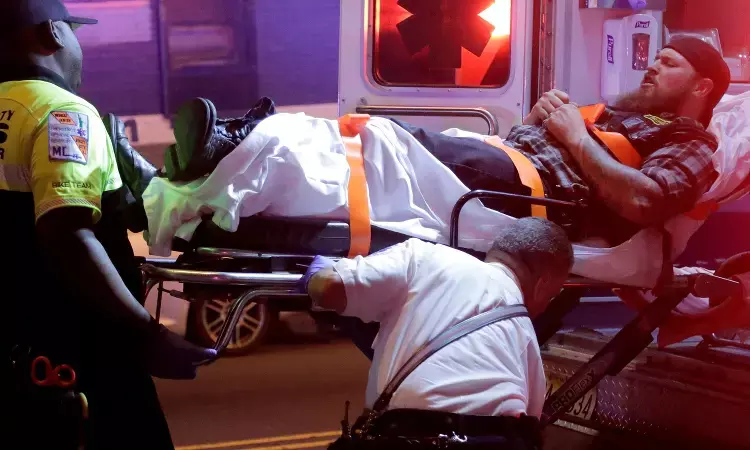- Home
- Medical news & Guidelines
- Anesthesiology
- Cardiology and CTVS
- Critical Care
- Dentistry
- Dermatology
- Diabetes and Endocrinology
- ENT
- Gastroenterology
- Medicine
- Nephrology
- Neurology
- Obstretics-Gynaecology
- Oncology
- Ophthalmology
- Orthopaedics
- Pediatrics-Neonatology
- Psychiatry
- Pulmonology
- Radiology
- Surgery
- Urology
- Laboratory Medicine
- Diet
- Nursing
- Paramedical
- Physiotherapy
- Health news
- Fact Check
- Bone Health Fact Check
- Brain Health Fact Check
- Cancer Related Fact Check
- Child Care Fact Check
- Dental and oral health fact check
- Diabetes and metabolic health fact check
- Diet and Nutrition Fact Check
- Eye and ENT Care Fact Check
- Fitness fact check
- Gut health fact check
- Heart health fact check
- Kidney health fact check
- Medical education fact check
- Men's health fact check
- Respiratory fact check
- Skin and hair care fact check
- Vaccine and Immunization fact check
- Women's health fact check
- AYUSH
- State News
- Andaman and Nicobar Islands
- Andhra Pradesh
- Arunachal Pradesh
- Assam
- Bihar
- Chandigarh
- Chattisgarh
- Dadra and Nagar Haveli
- Daman and Diu
- Delhi
- Goa
- Gujarat
- Haryana
- Himachal Pradesh
- Jammu & Kashmir
- Jharkhand
- Karnataka
- Kerala
- Ladakh
- Lakshadweep
- Madhya Pradesh
- Maharashtra
- Manipur
- Meghalaya
- Mizoram
- Nagaland
- Odisha
- Puducherry
- Punjab
- Rajasthan
- Sikkim
- Tamil Nadu
- Telangana
- Tripura
- Uttar Pradesh
- Uttrakhand
- West Bengal
- Medical Education
- Industry
Restrictive vs. liberal red blood cell transfusion strategy for critically injured patients

The restrictive transfusion strategy results in a lower red blood cell transfusion volume for critically injured patients suggests a new study published in the Journal of Intensive Care.
The efficacies of fresh frozen plasma and coagulation factor transfusion have been widely evaluated in trauma-induced coagulopathy management during the acute post-injury phase. However, the efficacy of red blood cell transfusion has not been adequately investigated in patients with severe trauma, and the optimal hemoglobin target level during the acute post-injury and resuscitation phases remains unclear. Therefore, this study aimed to examine whether a restrictive transfusion strategy was clinically non-inferior to a liberal transfusion strategy during the acute post-injury phase.
This cluster-randomized, crossover, non-inferiority multicenter trial was conducted at 22 tertiary emergency medical institutions in Japan and included adult patients with severe trauma at risk of major bleeding. The institutions were allocated a restrictive or liberal transfusion strategy (target hemoglobin levels: 7–9 or 10–12 g/dL, respectively). The strategies were applied to patients immediately after arrival at the emergency department. The primary outcome was 28-day survival after arrival at the emergency department. Secondary outcomes included transfusion volume, complication rates, and event-free days. The non-inferiority margin was set at 3%.
Results
The 28-day survival rates of patients in the restrictive (n = 216) and liberal (n = 195) strategy groups were 92.1% and 91.3%, respectively. The adjusted odds ratio for 28-day survival in the restrictive versus liberal strategy group was 1.02 (95% confidence interval: 0.49–2.13). Significant non-inferiority was not observed. Transfusion volumes and hemoglobin levels were lower in the restrictive strategy group than in the liberal strategy group. No between-group differences were noted in complication rates or event-free days.
Although non-inferiority of the restrictive versus liberal transfusion strategy for 28-day survival was not statistically significant, the mortality and complication rates were similar between the groups. The restrictive transfusion strategy results in a lower transfusion volume.
Reference:
Hayakawa, M., Tagami, T., Kudo, D. et al. The Restrictive Red Blood Cell Transfusion Strategy for Critically Injured Patients (RESTRIC) trial: a cluster-randomized, crossover, non-inferiority multicenter trial of restrictive transfusion in trauma. j intensive care 11, 34 (2023). https://doi.org/10.1186/s40560-023-00682-3
Keywords:
Restrictive, liberal, red blood, cell, transfusion, strategy, critically, injured patients, Hayakawa, M., Tagami, T., Kudo, D, Journal of Intensive Care
Dr. Shravani Dali has completed her BDS from Pravara institute of medical sciences, loni. Following which she extensively worked in the healthcare sector for 2+ years. She has been actively involved in writing blogs in field of health and wellness. Currently she is pursuing her Masters of public health-health administration from Tata institute of social sciences. She can be contacted at editorial@medicaldialogues.in.
Dr Kamal Kant Kohli-MBBS, DTCD- a chest specialist with more than 30 years of practice and a flair for writing clinical articles, Dr Kamal Kant Kohli joined Medical Dialogues as a Chief Editor of Medical News. Besides writing articles, as an editor, he proofreads and verifies all the medical content published on Medical Dialogues including those coming from journals, studies,medical conferences,guidelines etc. Email: drkohli@medicaldialogues.in. Contact no. 011-43720751


